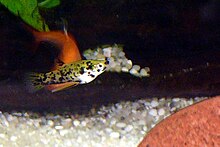| Phalloceros | |
|---|---|
 | |
| Dusky millions fish (P. caudimaculatus) | |
| Scientific classification | |
| Domain: | Eukaryota |
| Kingdom: | Animalia |
| Phylum: | Chordata |
| Class: | Actinopterygii |
| Order: | Cyprinodontiformes |
| Family: | Poeciliidae |
| Tribe: | Cnesterodontini |
| Genus: | Phalloceros C. H. Eigenmann, 1907 |
| Type species | |
| Girardinus caudimaculatus Hensel, 1868 [1] | |
Phalloceros is a genus of poeciliids native to freshwater habitats in Brazil, Paraguay, Uruguay and northern Argentina. The majority are endemic to southern and southeastern Brazil (only exceptions are P. caudimaculatus, P. harpagos and P. leticiae). [2] P. caudimaculatus has long been part of the aquarium industry and has been introduced to countries far from its native range.